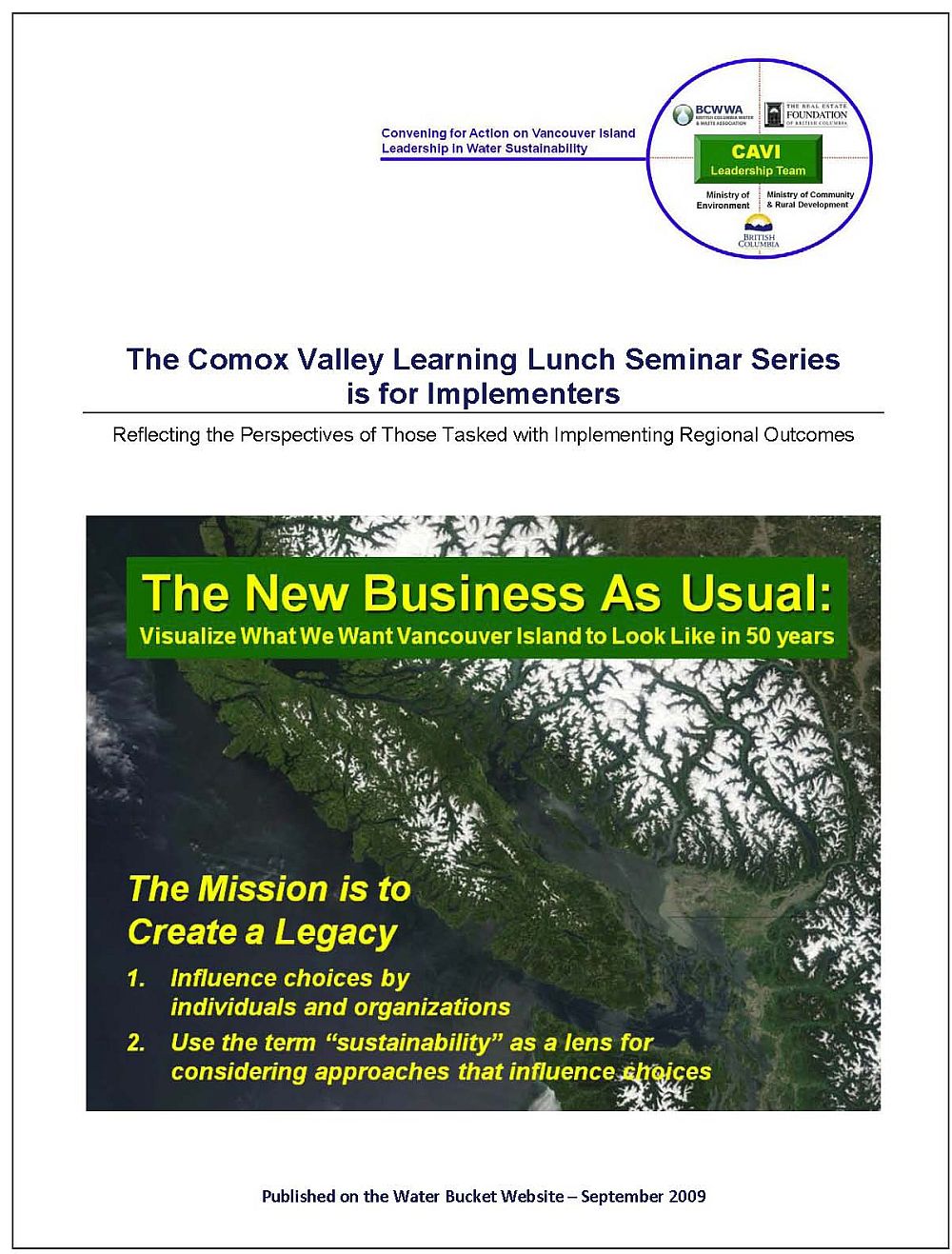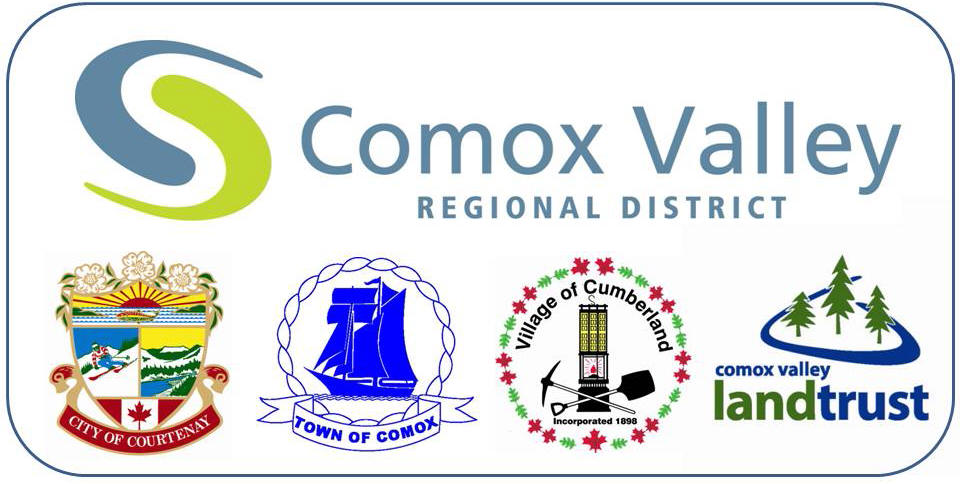GETTING AHEAD OF THE WAVE: “The Comox Valley Learning Lunch Seminar Series is for Implementers” – Story #6 in the ‘curriculum preview series’ for 2009 Comox Valley Learning Lunch Seminar Series reflected the perspectives of municipal staffs tasked with implementing regional outcomes
Note to Readers:
This article is the sixth in a series that will both set the scene and serve as a resource for the 2009 Comox Valley Learning Lunch Seminar Series. This Story #6 is an abridged version of an article that is seven pages in length. To read the complete article, click on this link to download a PDF version of The Comox Valley Learning Lunch Seminar Series is for Implementers.
The following abridged version highlights the individual municipal perspectives. The downloadable version of the complete article elaborates on how integration of the Development Permit Areas planning tool with engineering objectives will be addressed during the Town Hall session at Seminar #1.

Reflecting the Perspectives of Those Tasked with Implementing Regional Outcomes
There are a myriad of regional initiatives underway in the Comox Valley. At the end of the day, all the plans will have to be integrated and delivered by the three municipalities. So, what does integration look like?
The Key Word is Alignment
 Kevin Lagan, Director of Operational Services for the City of Courtenay, provides this perspective: “Visioning workshops are great in terms of creating a picture of the desired destination, BUT a critical question is what must we do starting NOW to make the vision a reality? The key word is alignment: once we agree on what we want to collectively achieve, then we can focus on how we will work together to get there.”
Kevin Lagan, Director of Operational Services for the City of Courtenay, provides this perspective: “Visioning workshops are great in terms of creating a picture of the desired destination, BUT a critical question is what must we do starting NOW to make the vision a reality? The key word is alignment: once we agree on what we want to collectively achieve, then we can focus on how we will work together to get there.”
Regional Team Approach
 “The term ‘regional approach’ has been part our vocabulary for a generation or more, but it has never resonated the way ‘regional team approach’ has resonated this past year in the Comox Valley,” observes Tim Pringle, Director of Special Programs for the Real Estate Foundation, a co-funder of CAVI-Convening for Action on Vancouver Island.
“The term ‘regional approach’ has been part our vocabulary for a generation or more, but it has never resonated the way ‘regional team approach’ has resonated this past year in the Comox Valley,” observes Tim Pringle, Director of Special Programs for the Real Estate Foundation, a co-funder of CAVI-Convening for Action on Vancouver Island.
“It is revealing that inserting the word team could have such a profound impact on how practitioners view their world. Inclusion of the team word implies there is personal commitment – that is why the regional team approach is fundamentally different than a regional approach.”
Implementation of a Regional Team Approach
A regional team approach is founded on partnerships and collaboration; and seeks to align actions at three scales – provincial, regional and local.
A Village of Cumberland Perspective
“As I see it, the power of the 2009 Learning Lunch Series results from the fact that it is internally driven by staff. As a result, the process of organizing the series and developing the curriculum is already enabling people in all four local governments to work together,” states Judith Walker, Municipal Planner with the Village of Cumberland.
“Yes, the 2009 Series is time-intensive; and yes, there is more work for staff to do. But, in the big picture this is actually a positive because the learning outcomes will then last longer. At the end of the series, a clear benefit will be that we will all have the same story….no matter where you go in the valley.”
A Town of Comox Perspective
 “The regional team approach is exciting because it will enable us to set a direction,” states Marvin Kamenz, Municipal Planner with the Town of Comox.“We have the tools. We have the knowledge. Now we all need is the formal mandate to get on with watershed-based land use planning.”
“The regional team approach is exciting because it will enable us to set a direction,” states Marvin Kamenz, Municipal Planner with the Town of Comox.“We have the tools. We have the knowledge. Now we all need is the formal mandate to get on with watershed-based land use planning.”
“There is an array of planning tools to select from, including the Development Permit Area. It is a matter of how to strategically apply the appropriate tool to achieve the desired outcome. So the key is being clear on what we wish to accomplish, and then explaining to the public why we are doing it.”
 “Watershed-based land use planning has real meaning on the ground for the Town of Comox,” continues Glenn Westendorp, Public Works Superintendent. “Because we are downstream of future developments located within the regional district, we require a unified and consistent regional approach to rainwater / stormwater management and green infrastructure.”
“Watershed-based land use planning has real meaning on the ground for the Town of Comox,” continues Glenn Westendorp, Public Works Superintendent. “Because we are downstream of future developments located within the regional district, we require a unified and consistent regional approach to rainwater / stormwater management and green infrastructure.”
A City of Courtenay Perspective
“Going forward, Comox Valley municipalities must work together to control the look-and-feel of proposed new developments,” states Kevin Lagan. “The Comox Valley has a unique opportunity to let our actions do the talking. We can all be part of the regional plan, and we can all run with the plan.
“The Development Permit Area planning tool can provide us with a means to an end, that is: we can achieve commonality as to how developments fit together at our boundaries. By having common development objectives, the DPA effectively creates the opportunity for a ‘soft boundary’ so that there is a seamless transition from one jurisdiction to the next.”
 “The 2008 Series was educational in terms of desired outcome. The 2009 Series is designed to be transformational,” continues Derek Richmond, Manager of Engineering. “By drawing attention to HOW we can integrate the DPA planning tool with engineering objectives, this will get everyone thinking about the parts of the machine. But we wish to go beyond just thinking….we will be seeking commitment by all the groups to build the machine.”
“The 2008 Series was educational in terms of desired outcome. The 2009 Series is designed to be transformational,” continues Derek Richmond, Manager of Engineering. “By drawing attention to HOW we can integrate the DPA planning tool with engineering objectives, this will get everyone thinking about the parts of the machine. But we wish to go beyond just thinking….we will be seeking commitment by all the groups to build the machine.”
The Collaboration Challenge
 The challenge statement below frames the learning outcomes for local governments when convening for action before, at and after the 2009 Learning Lunch Series.
The challenge statement below frames the learning outcomes for local governments when convening for action before, at and after the 2009 Learning Lunch Series.
“In rising to the collaboration challenge for working together, the essence of the regional team approach is that all the players will set their sights on the common good and challenge the old barriers of jurisdictional interests,” states Eric Bonham, Chair of the Highlands Foundation and a founding member of the CAVI Leadership Team; and formerly a Director in the Ministry of Municipal Affairs.



